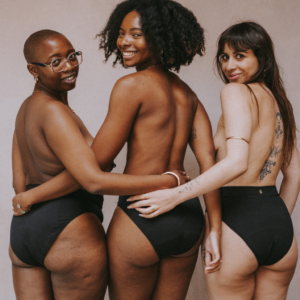Polyester – first created in the 1940s, however was not popularised until the 1970s when advertised as a ‘miracle fibre’ due to its diverse nature. Polyester fabric is very widely used and can be found in countless garments within peoples wardrobes worldwide.
The polyester industry is extremely valuable and complex – and we will discover why in detail within this blog post.
Overview of polyester
Polyester is a synthetic fibre derived from petroleum and is mostly considered a plastic, it has many beneficial properties which have propelled it into mass consumption by the fashion industry.
It can be used in clothing, furnishings and much more. polyester, despite its popularity, carries some bad connotations due to the nature of what it is and how it is produced, with some individuals linking synthetic fabrics to the increased environmental risk we are currently undertaking.
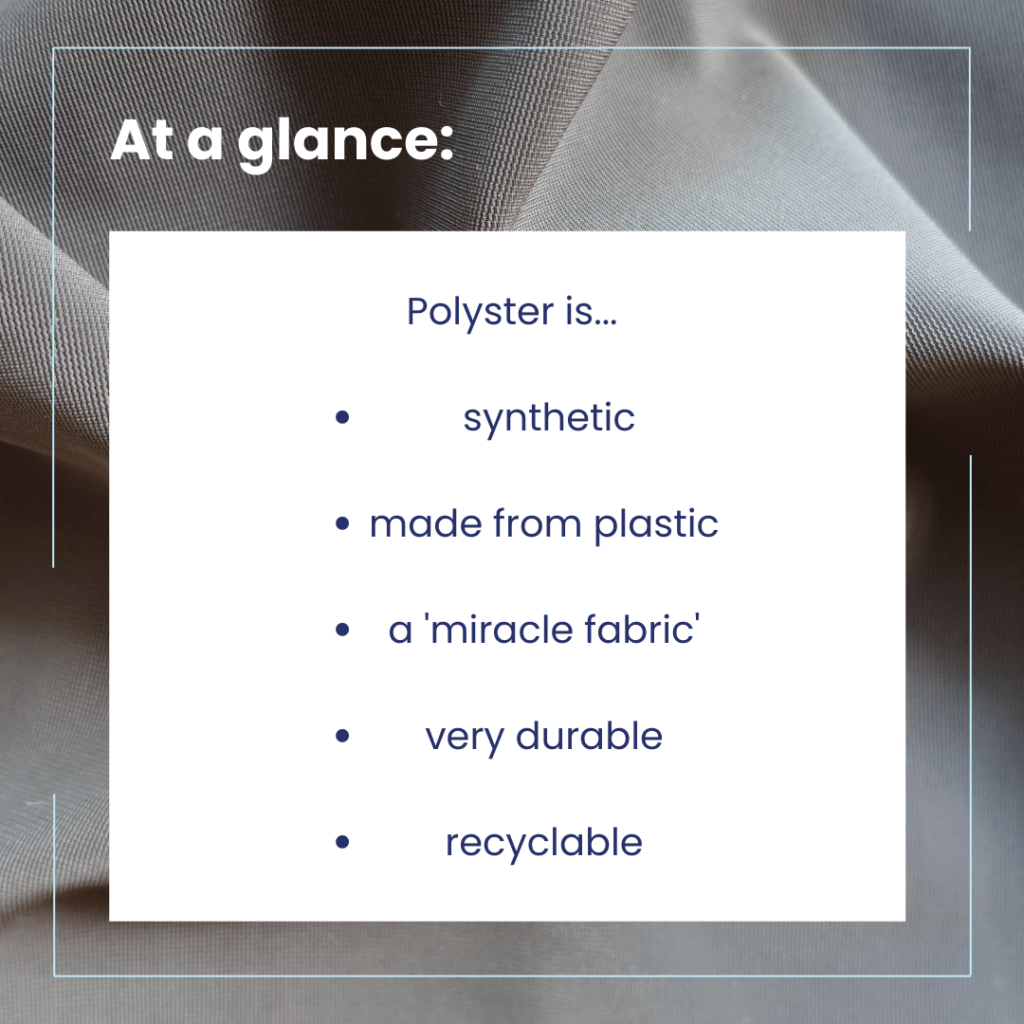
Polyester origin, types and location
In 1926, a United States-based company began research into molecules and synthetic fibers. They went on to create the first ever synthetic fibre Nylon, and in the late 1930s and early 1940s, British scientists conducted their own research on synthetic fibres resulting in the creation of polyester.
Polyester entered the economy for the first time as Terylene by W.H. Carothers. Polyester fabric was produced for mass consumption by the DuPont Corporation and was marketed under the name Dacron, and was widely used within war efforts to make parachutes by a multitude of American companies.
PET or PCDT?
Polyester carried on developing over the years all around the world, and today there are two primary types – PET (polyethylene terephthalate) and PCDT (poly-1, 4-cyclohexylene-dimethylene terephthalate).
PET (also known as ethylene polyester) is the type of polyester we are most used to seeing within our clothing, and is produced widely within the fashion industry as it has a variety of uses and is stronger than PCDT.
There are four different ways to make PET fiber, and the production process used varies depending on whether it is making filament, staple, tow or fibrefill polyester types.
PCDT has a different chemical structure and is much more resilient than PET, with more elasticity, and PCDT is suited to heavier uses such as curtains and other home furnishings.
Where is it produced today?
Polyester is one of the most used fabrics worldwide – and this means that it has to be produced on a global scale.
China is the largest producer of filament and staple polyester fibers as well as being the largest polyester market in the world. China has many specialist factories with expensive machinery tailored to perfecting fabric production processes, and this is one of the reasons that they are the largest producers today.
Other reasons for China leading the way for polyester fabric production include the fact that it is an emerging market with low-cost manufacturing and many government initiatives. This is also the reason for India being the second largest producer of polyester around the globe.
Some of the biggest manufacturers of Polyester include:
- Alpek – a leading producer of PTA and PET globally and one of the largest expandable polystyrene manufacturers in America
- Bombay Dyeing – a producer of a wide range of polyester Staple Fibers (PSF) from 0.6 to 7 deniers located in India
- China Petrochemical – one of the largest oil refining, gas and petrochemical conglomerates and top polyester manufacturers in the world located in Shanghai
- Indorama Ventures – one of the leading producers in the intermediate petrochemicals industry established in Bangkok
Other manufacturers of polyester include Taiwan, Korea, Japan, and Indonesia. polyester is mainly kept in Asia after fabric production is completed until it has been turned into full garments.
How is polyester fabric made?
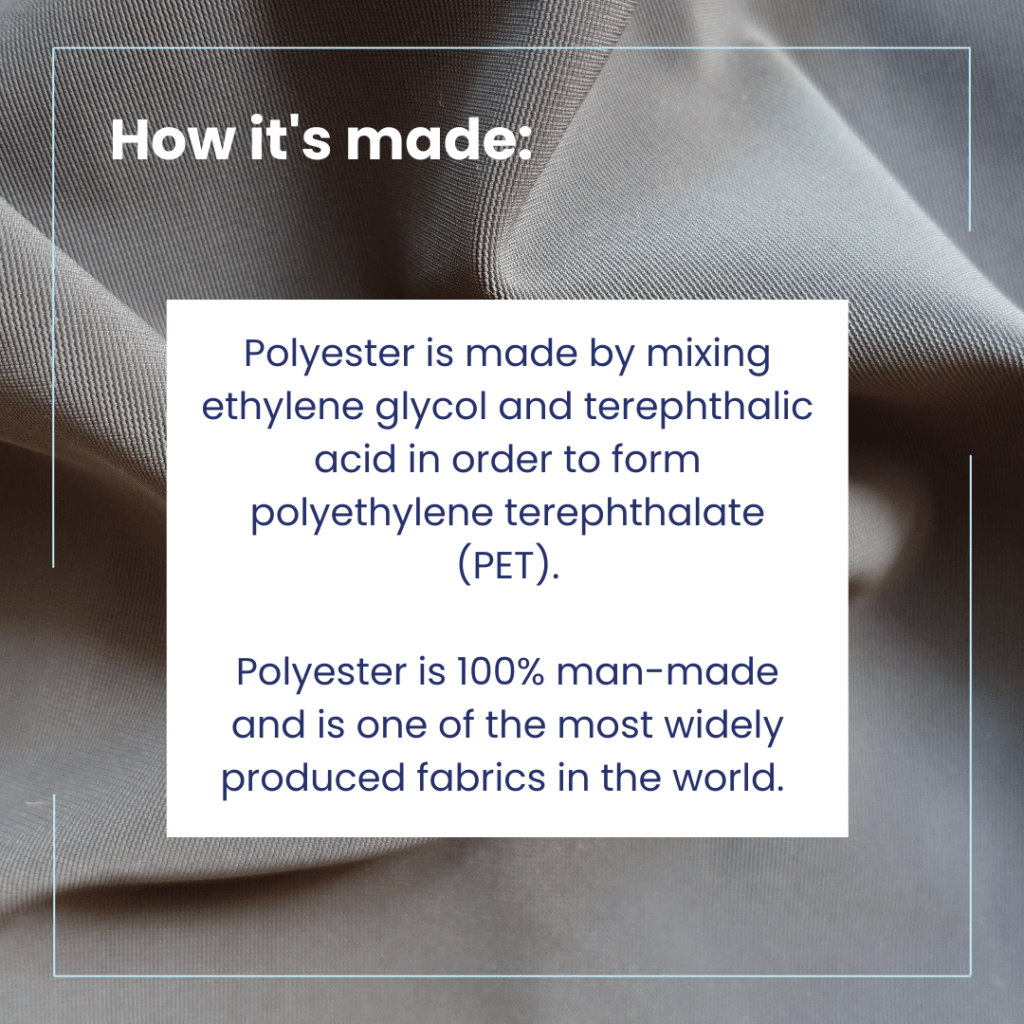
The manufacturing process depends heavily on what type of polyester is being made. Within PET production – as mentioned above, there are 4 different types of polyester fibres – filament, staple, tow and fibrefill, however only 2 types are regularly produced for fabric.
Filament
Filament fibres are continuous fibres that go on to produce soft fabrics and are frequently used within polyester fabric manufacturing. To product filament polyester these steps are carried out:
- Polymerization – dimethyl terephthalate is reacted with ethylene glycol with a catalyst between the temperatures 150-210°C. This chemical is then combined with terephthalic acid and raised to 280°C. The molten polyester is then extruded to form long, clear ribbons.
- Drying – after the polyester emerges from polymerization, the ribbons are allowed to cool until they are hard. The material is then cut into pieces and dried to ensure the consistency is the same.
- Melt spinning – the pieces are melted at 260-270°C to form a syrup-like solution. This is put into a metal container called a spinneret and forced through tiny holes – the shape of which determines the type of fibre. The number of holes will create different sizes of yarn. In this stage, other chemicals may be added to make the polyester flame retardant, antistatic, or easier to dye.
- Drawing the fiber – once emerged, the polyester is soft and easily stretched. The strength, tenacity, and resilience of the fiber can be increased through the stretching process. Once the filaments dry, the fibers become solid and strong instead of brittle. The characteristics of the finished material will mean fibres vary in diameter and length, or textured and twisted to create softer or duller fabrics.
- Winding – after the polyester yarn has been drawn, it is wound on large bobbins or flat-wound packages, ready to be woven into material.
Staple
To make staple fibers, polymerization, drying, and melt spinning are similar to the manufacture of filament yarn. However, in the melt spinning process, the spinneret has many more holes. The rope-like bundles of polyester that emerge are called tow.
- Drawing tow – the newly-formed tow is cooled in cans that gather thick fibers. Several lengths of the tow are gathered and then drawn on heated rollers to three or four times their original length.
- Crimping – drawn tow is then fed into boxes that compress them, forcing the fibers to fold like an accordion – this process helps the fiber hold together during the later manufacturing stages.
- Setting – after the tow is crimped, it is heated at 100-150°C to completely dry the fibers and set the crimp. Some of the crimp will inevitably be pulled out of the fibers during the following processes.
- Cutting – following heat setting, tow is cut into shorter lengths. Polyester that will be blended with cotton is cut in 1.25-1.50 inch pieces; for rayon blends, 2 inch lengths are cut. For heavier fabrics, such as carpet, polyester filaments are cut into 6 inch lengths. (http://www.madehow.com/Volume-2/Polyester.html#ixzz7DclY5mnp)
Polyester fabric properties
Polyester has a huge variety of beneficial properties which is why it is used in so many products within the fashion industry and beyond from high-street brands to designers.
Durable
Polyester is extremely durable – it was initially used for parachutes and it is resistant to pilling, stretching and shrinking which is one reason that it is so often used in everyday clothes that will be worn a lot.
As a synthetic fibre it is much more resistant than natural fabrics, including resistance to other chemicals, and this means that polyester will frequently be chosen over its natural fibre competitors such as cotton or linen.
Retains shape
Polyester has the incredible ability to retain the shape that it is made into. This means that it is perfect to hold the structure of pleats, gathers and ruffles without them losing shape over time.
This also means that polyester is very wrinkle resistant, and does not require being ironed or steamed to look presentable.
Moisture-wicking
Polyester is the best moisture-wicking fabric on the market for the sole reason that it has the ability to draw moisture away from the body. Instead of absorbing moisture like other types of fabric, polyester wicks the liquid in the first layer of the fabric.
This means that you will not be able to feel moisture on your skin, and the sweat will be able to evaporate quickly so that you are never able to feel it. This is why polyester is so often used within activewear such as running gear.
Strong
The reason for polyester’s durability is that it is such a strong fibre. Being a synthetic compound, fibres are not easily broken. Polyester is able to handle abrasion and will not rip or tear easily.
The downside to its strength is that it is not the most luxurious fabric, it feels sturdy and coarse and therefore is not often used for finer quality products.
Easy to care for
Polyester is very easy to care for. It can be washed on any setting without the worry of shrinking or creasing and is able to be tumble dried as well as air dried.
Many designer brands will use polyester even though they can afford higher quality fabrics because they know their consumer will be able to easily take care of the products. They do not want their items ruined after one wash, and therefore will sacrifice comfort and luxury for simplicity.
Breathable
Polyester is breathable because it is moisture-wicking, however it is nowhere near as breathable as natural fabrics. Polyester will trap heat and sweat into the top layers of the fabric instead of being absorbed which creates a barrier. This can make the person wearing it very hot in the heat or not warm enough in the cold.
Non-biodegradable
Polyester is unable to biodegrade due to the fact that it is completely synthetic. If polyester ends up being thrown away, it will sit in landfill indefinitely because there is no way for it to break down.
Due to being used so frequently and often by fast-fashion brands, polyester makes up a large percentage of the world’s waste products.
Polyester fabric products
Polyester is used in a whole array of products within the fashion industry including clothing, accessories, and home furnishings.
Athletic wear
Polyester is frequently used in all types of athletic wear because of its durable properties and its ability to blend extremely well with other fibres. Polyester is often improved on when blended, such as elasticity when blended with elastane.
Items such as leggings, t-shirts, and sports bras can be made from a blend of polyester.
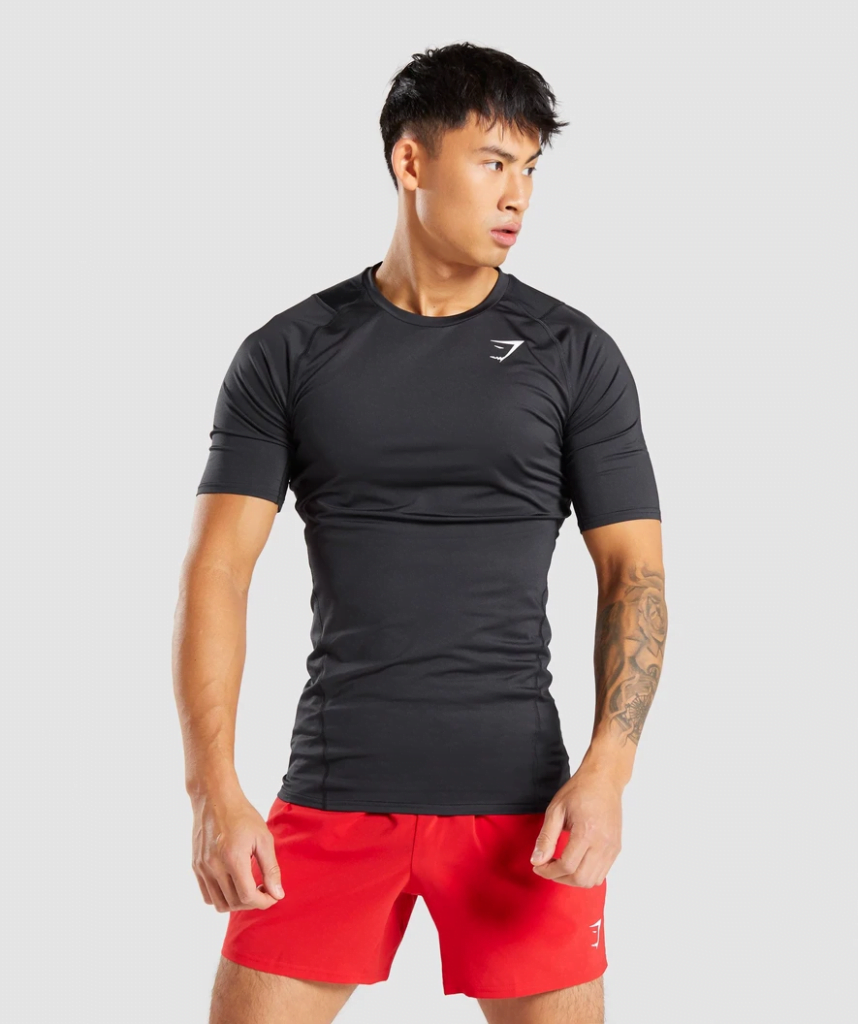
Outdoor essentials
Polyester garments are durable and moisture-wicking which makes them the perfect choice for outdoor clothing that is required to keep you warm and dry in all different types of weather.
Polyester fabric can be seen in a range of outdoor essentials from jackets and windbreakers to climbing suits.
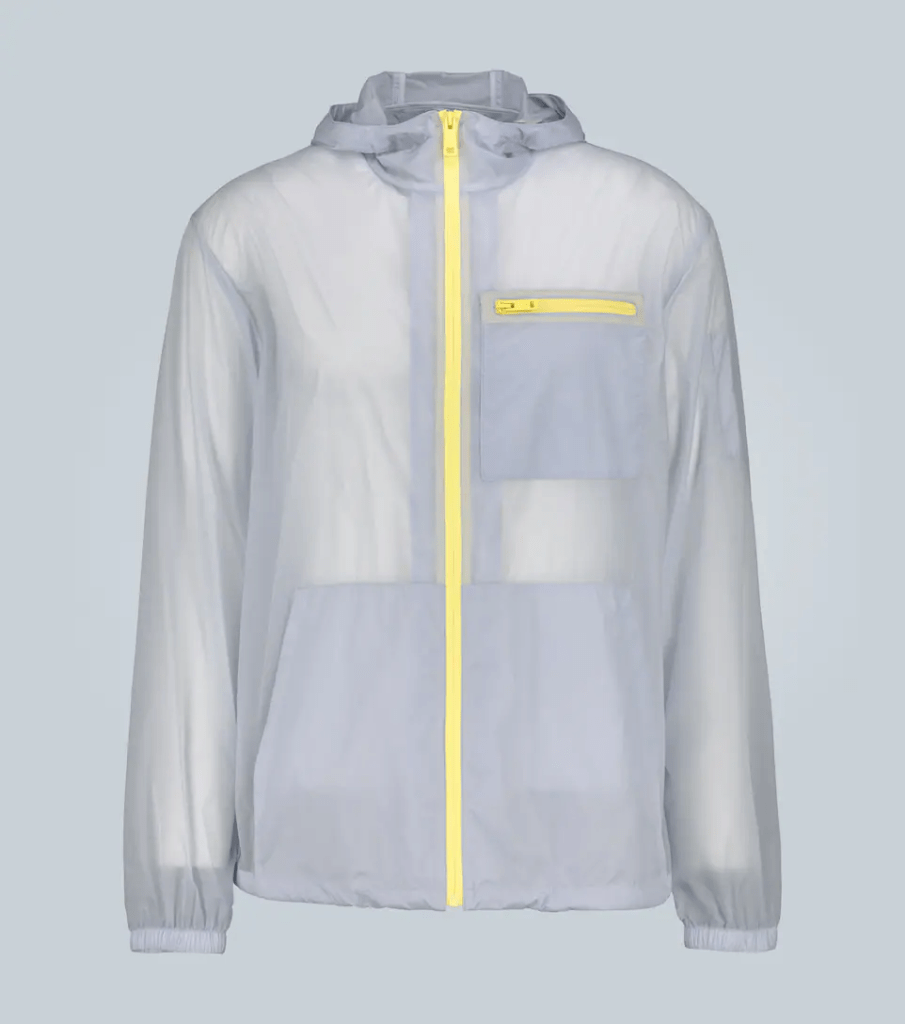
Bags
Polyester is a great material for bags such as backpacks and tote bags because of its strength and availability, polyester is also a very cheap fabric to use within products so simple items such as these are a very common place to see polyester used.
Home furnishings
Polyester staples and filaments can be found in curtains, cushion covers, upholstery, carpets, table cloths, bed sheets and pillow cases. Fibrefill polyester can also be used in these areas as stuffing for pillows and cushions.

Sustainable impact of Polyester
The sustainable impact of polyester is more often than not, a negative one. It remains one of the most harmful materials to produce due to the fact that there are negative aspects at every stage of production and lifecycle.
Polyester is a synthetic fabric made of plastics from fossil fuels which have detrimental effects to the environment around us. Due to the global scale in which polyester is produced, the usage of these fossil fuels is extremely harmful and has many sustainable impacts.
Producing petroleum also creates toxins that poison ecosystems and the people that live within them, creating polyester also creates byproducts which are synthetic and will not break down. Dyes and extra treatments also leech into the environment from manufacturers making the products.
Polyester also has ethical concerns such as factories using slave labour whilst exposing the workers to toxic conditions which could cause cancer and other fatal conditions.
Polyester also produces microfibres which can get into the ocean and harm marine life, whilst contaminating drinking water. Polyester cannot biodegrade and therefore these microfibres will remain there forever. This also means that once thrown away, polyester will sit in landfill for centuries and will never be broken down.
Polyester can be recycled however, and repurposed back into garments and other textiles for reuse, however this is not infinite and the majority of polyester isn’t recycled yet. Recycling still has a long way to go in order to make polyester a more sustainable option. To read more about recycled fabrics such as polyester, check out our recycled fashion blog, as well as our series of other fabric breakdown posts.

